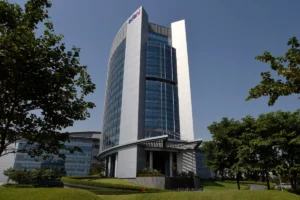
Biparjoy Begins Making Landfall In Gujarat's Kutch Region Close To Jakhau Port
Cyclone Biparjoy has begun making landfall near Jakhau Port in Gujarat’s Kutch area after churning across the Arabian Sea for more than 10 days, according to the India Meteorological Department (IMD) on Thursday evening. As agencies continue to be on high alert, strong gusts and heavy rains pummelling the coastlines of Kutch and Saurashtra.
By midnight, the landfall procedure will be finished. “Dense convective clouds have entered the districts of Kutch and Devbhumi Dwarka, and the landfall process has started. According to IMD Director General Mrutyunjay Mohapatra, it will go on until midnight.
The cyclone’s eye has a diameter of about 50 kilometres. With a marching speed of 13–14 kmph, Biparjoy is moving forward. As a result, he estimated that the wall cloud and the eye would take around five hours to completely pass onto the land.
After receiving a prompt alert from the IMD regarding the “extensive damaging potential” of the cyclone, authorities quickly ordered the evacuation of approximately one lakh residents of susceptible districts.
According to officials,
Personnel from the Indian Army, Navy, Air Force, Indian Coast Guard, and Border Security Force have been sent for relief and rescue efforts, along with 12 teams from the State Disaster Response Force and 15 NDRF teams.
The Met office has already issued a warning for exceptionally high rainfall (above 20.5 cm) in the districts of Kutch, Devbhumi Dwarka, Jamnagar, Porbandar, Rajkot, Morbi, and Junagarh.
“We won’t be surprised if some areas record more than 25 cm of rainfall. Usually, they do not receive such intense precipitation at this time of the year. Therefore, there is a risk of flooding in the low-lying areas,” Mohapatra had cautioned.
The significant flooding of escape routes and damage to standing crops, homes, highways, electricity, and communication poles had been foreseen by meteorologists.
Low-lying portions of the Kutch and Saurashtra beaches could be submerged by enormous tides, they warned.
Since Wednesday, there have been numerous coastal Gujarat locations with heavy rain and strong gusts.
All activities, including oil drilling, ship movement, and fishing, have been suspended due to the extraordinary sea conditions in the northeast and the adjacent east-central Arabian Sea (waves there could reach 10 to 14 metres high).
On May 17, 2021, cyclone Tauktae made landfall on Gujarat’s southern coast as India struggled with a ferocious COVID-19 second wave.
The US Joint Typhoon Warning Centre said that Tauktae had winds with a maximum sustained speed of up to 185 kmph, making it the “strongest tropical cyclone” to hit the west coast of India in at least two decades.
In defiance of prior forecasts, Biparjoy, this year’s first cyclone in the Arabian Sea, underwent quick development on June 6 and June 7. In just 48 hours, it moved from a cyclonic circulation to a very severe cyclonic storm.
Additionally,
It has remained strong for a longer period of time than typical, which meteorologists ascribe to an exceptionally warm Arabian Sea.
According to IMD data, Biparjoy has grown to be the cyclone in the Arabian Sea with the greatest life span.
The life of Biparjoy, which began at 5.30 am on June 6 over the southeast Arabian Sea, has lasted for approximately 10 days and 12 hours.
2019’s very dangerous Cyclone Kyarr over the Arabian Sea only lasted 9 days, 15 hours. It began to form over the east-central Arabian Sea, through several recurvations, and then began to lose strength over the southwest Arabian Sea.
The very severe cyclonic storm Gaja of 2018 over the southeast Bay of Bengal had a life span of 9 days and 15 hours. It crossed the southern peninsular region, emerged into the Arabian Sea and weakened there, the IMD said.
According to scientists,
Climate change has caused cyclonic storms in the Arabian Sea and Bay of Bengal to intensify quickly and hold their intensity for longer periods of time.
Also read: BJP Leader Rejoins Congress In 400 Siren Blaring Car Cavalcade, Video Goes Viral
To read more such news, download Bharat Express news apps






































